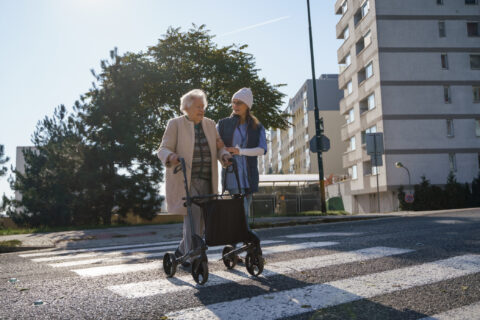As local leaders look to increase the economic mobility of their residents and reduce poverty in their communities, a key emerging area to address is transportation. As shared on a Next City and Via webinar, 87 percent of public transportation trips connect riders to employment opportunities and local businesses, and every dollar invested in a transportation network results in a four-dollar return on investment. Without adequate and affordable mobility options, the likelihood that an individual or family can be economically stable and move to build wealth over time decreases.
Multiple research studies show a link between access to transportation and economic mobility. One study found that the longer average commute time in a county lessened the chance for a low-income family to become financially secure. A separate study conducted by the Federal Reserve Bank of Cleveland found that in Allegheny County, PA, only 10 percent of jobs are accessible within a 60-minute commute time via transit for workers with a high school degree or less. Additionally, a sizable U.S. population cannot or should not drive, necessitating accessible non-automobile travel, including seniors, youths, adults unable to drive, and people without a driver’s license. Thinking about how to link residents in these populations to transportation can help connect them to economic opportunities that lead to upward economic mobility, which in turn increases economic development for the community.
How Wilson, NC is Working to Bridge These Gaps
Municipalities like Wilson, NC, are rethinking how they can utilize on-demand transit to better connect residents to employers. With economic centers shifting, the city changed from a fixed route service to an on-demand service known as RIDE with the company Via as a partner. They used the same budget to increase transit coverage from 40 percent to 100 percent of the city. To help cover employment opportunities in second and third shifts, the city applied for and won a Federal Transit Administration Accelerating Innovative Mobility grant. A majority of riders report an annual household income under 25K (57 percent), identify as a minority (80 percent), and lack access to a personal vehicle (86 percent).
The City of Wilson and local community organizations also recognized that access alone wasn’t the only mobility issue for their community. Many of their riders were also unbanked or needed a smartphone to access the transportation app-based system. The city partnered with community organizations to provide residents with both online and call-based bookings so residents can access transportation. For underbanked residents, these organizations are helping riders get prepaid vouchers that are accepted by the service.
Where to Start
Local leaders can take action on transit regardless of the size of their community. For example, municipal leaders can engage their regional peers and county to work with partners such as nonprofit service providers, anchor institutions such as community colleges, and employers to better understand how community transportation efforts impact residents, employees, and employers. While working to put surveys into the community, local leaders should also review any transportation assessments, planning, and route maps to confirm the status of the services offered, paying special attention to whether lower-income neighborhoods have transit connections to stable, higher-wage work.
Beyond understanding what is happening and what the community believes is happening, and what it needs, local leaders should think about how each of their community groups offers an opportunity to address the challenge. Some opportunities could include:
- Working with state and federal partners to create a park-and-ride space within a targeted area. This would allow workers to drive or walk a short distance before securing additional transportation to employment opportunities outside the locality. Localities should work with employers on these developments so that regional transportation can serve all shift workers.
- Working with employers to increase transportation options for their employees. In their role, employers see what the issue of transportation does to their employees, from not arriving on time to missed shifts that lead to turnover. Employers can work together to create targeted shift transportation. For example, employers within industrial parks can work together to secure transportation for their workforce, similar but smaller in scale to the park-and-ride option. Additionally, employers or chambers of commerce can work with local financial institutions to offer their employees access to safe and affordable payroll advance loans that employees can use to purchase a used car.
- Working with nonprofit partners to advance used car savings or purchasing programs. While public transportation networks may work well for denser communities, less dense communities may need to find ways to help households without a personal vehicle acquire one. Several studies have found that vehicle ownership increases job accessibility. One program that helps low-income individuals purchase a car is Vehicles for Change. Vehicles for Change repairs cars that meet quality standards and award them for as little as $950 to eligible families referred to them by social service agencies.
Municipal leaders can also work to advance programming within their jurisdiction, including creating Individual Development Accounts (IDA) that are targeted at used car down payments, working with local lenders to help residents refinance their auto loans so they can get better rates, and working with local brokers to help residents secure car insurance. Local leaders can push for stronger partnerships and programming that helps residents achieve financial security in the short term and economic mobility over time. Transportation is a key driver in that journey, and all communities have the keys to secure success.
Learn More
To learn more about the drivers of economic mobility, join NLC’s Economic Mobility Peer Network.










